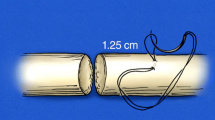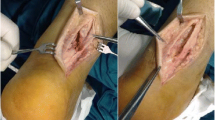Abstract
Flexor tendon laceration repairs remain challenging despite numerous advances in hand surgery. Although progress on this vital subject matter has been achieved, there continues to be discussion over which surgical technique produces the optimal result. Currently there are several recommended surgical repair options for the lacerated flexor tendon. However, these repairs continue to have possible significant complications including adhesions, decreased range of motion, gapping, and post operative rupture. Stainless steel suture has long been known as an option for flexor tendon repair. Stainless steel suture demonstrates one of the highest tensile strength sutures. However until recently, stainless steel suture placement for flexor tendon repairs was technically problematic. This case study discusses an additional option for repairing lacerated flexor tendons using an advanced stainless steel tendon repair system.
Similar content being viewed by others
References
Strickland JW, Glogovac SV (1980) Digital function following flexor tendon repair in zone II: A comparison of immobilization and controlled passive motion techniques. J Hand Surg 5:537–543
Boyer MI, Taras JS, Kaufmann RA (2005) Flexor Tendon Injury. Green’s Operative Hand Surgery (eds) Green DP, Hotchkiss RN, Pederson WC and Wolfe SW, 4th ed, vol 1, Philadelphia, Churchill Livingstone, pp. 219–276
Wada A, Kubota H, Miyanishi K et al. (2001) Comparison of postoperative early active mobilization and immobilization in vivo utilizing a four-strand flexor tendon repair. J Hand Surg 26(4):301–306
Rocchi L, Merolli A, Genzini A et al. (2008) Flexor tendon injuries of the hand treated with Teno Fix: mid-term results. J Orthopaed Traumatol 9:201–208
Wolfe S, Willis A, Campbell et al. (2007) Biomechanic comparison of the Teno Fix tendon repair device with the cruciate and modified Kessler techniques. J Hand Surg 32(3):356–366
Lewis N, Quitkin H (2003) Strength analysis and comparison of the Teno Fix Tendon Repair System with the two-strand modified Kessler repair in the Achilles tendon. Foot & Ankle Inter 24(11):857–860
Su B, Solomons M, Barrow A et al. (2006) A device for Zone II Flexor Tendon Repair: Surgical Technique. JBJS 88Supp (1):37–49
Su B, Solomons M, Barrow A et al. (2005) Device for Zone II flexor tendon repair: A multicenter, randomized, blinded, clinical trial. JBJS 87(A5):923–935
Author information
Authors and Affiliations
Rights and permissions
About this article
Cite this article
Kubat, W.D., Hsu, J., Azharian, A. et al. The use of Teno Fix tendon repair device in a patient with multiple flexor tendon ruptures. J Hand Microsurg 2, 28–30 (2010). https://doi.org/10.1007/s12593-010-0004-9
Received:
Accepted:
Published:
Issue Date:
DOI: https://doi.org/10.1007/s12593-010-0004-9




